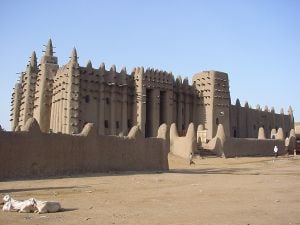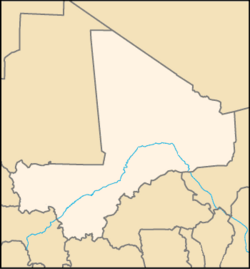Djenné
| Old Towns of Djenné* | |
|---|---|
| UNESCO World Heritage Site | |

| |
| State Party | |
| Type | Cultural |
| Criteria | iii, iv |
| Reference | 116 |
| Region** | Africa |
| Inscription history | |
| Inscription | 1988 (12th Session) |
| * Name as inscribed on World Heritage List. ** Region as classified by UNESCO. | |
| Djenné | |
| transliteration(s) | |
| Coordinates: 13°54′N 4°33′W | |
|---|---|
| Country | |
| Region | Mopti Region |
| Cercle | Djenné |
| Settled | 1043 |
| Population (1987) | |
| - Total | 12,000 |
Djenné (also Dienné or Jenne) is a historically and commercially important small city in the Niger Inland Delta of central Mali. It is just west of the Bani River (the Niger River passes well to the west and north). It has an ethnically diverse population of about 12,000 (in 1987). It is famous for its mud brick (adobe) architecture, most notably the Great Mosque of Djenné, originally built in 1220 and rebuilt in 1907. In the past, Djenné was a centre of trade and learning, and has been conquered a number of times since its founding. It is the oldest known city in sub-Saharan Africa,[1] and its historic city center was designated a World Heritage Site by UNESCO in 1988. Administratively it is part of the Mopti Region.
History
Djenné was founded in about 800 C.E. by the Bozo people at a site known as Djenné-Jeno, 1.5 km upstream. It moved its site in either 1043 or the 13th century, when the city converted to Islam. This increased its importance as a market and a base for trans-Saharan trade, soon rivaling Timbuktu.
Djenné, despite its proximity, was never part of the Mali Empire. It existed as an independent city-state protected by walls and the geography of the inland delta. According to legend, the Mali Empire attempted to conquer the city 99 times before giving up. Djenné would not be conquered until 1473 by the Songhai Empire under Sonni Ali. The siege of Djenné is said to have lasted 7 months and 7 days culminating in the death of the city's king and its capitulation. The widow of the city married Sonni Ali, and peace was restored. In 1591, Morocco conquered the city after destroying Songhai's hold in the region. By the 1600s, Djenné had become a thriving centre of trade and learning. Caravans from Djenné frequented southern trading towns like Begho, Bono Manso, and Bonduku.
The city continued to change hands several times. Djenné was part of the Segou kingdom from 1670 to 1818, Massina under the Fulani ruler Amadou Lobbo from 1818 to 1861, and the Toucouleur Empire under Umar Tall from 1861 to 1893. The French finally conquered the city that year. During this period, trade declined and the city's importance with it.
Sights
Attractions include the tomb of Tupama Djenepo, who in legend was sacrificed on the founding of the city, and the remains of Jenné-Jeno, a major city from the 3rd century B.C.E. until the 13th century.
Approximately eight hours by road from Bamako, Djenné is notable in that it becomes an island when the rivers rise at the end of the rainy season. However, problems of a different nature were reported in 2008 when it was said that Djenné was "drying up" because of a controversial dam, completed in 2007, across the Bani River at Talo, about 150 km upstream.[2] The weekly market, when buyers and sellers converge on the town from the surrounding regions, is a key tourist attraction.
Due to an unsavory incident with an Italian fashion photography shoot, the great mosque is out of bounds for non-Muslim tourists.
Demographics
The inhabitants of Djenné mostly speak a Songhay variety termed Djenné Chiini, but the languages spoken also reflect the diversity of the area. The villages around it variously speak Bozo, Fulfulde, or Bambara.
Notes
ReferencesISBN links support NWE through referral fees
- Jackson, John G., John Henrik Clarke, and Runoko Rashidi. 2001. Introduction to African civilizations. New York: Citadel Press. ISBN 0806521899 and ISBN 9780806521893
External links
All links Retrieved May 17, 2008.
- Old Towns of Djenné
- Mali Empire and Djenne Figures
- Djenné
- Villages around Djenné
- Djenné, Mali
- Mosque at Djenné – the Largest Building from Mud Brick – Mali
Credits
New World Encyclopedia writers and editors rewrote and completed the Wikipedia article in accordance with New World Encyclopedia standards. This article abides by terms of the Creative Commons CC-by-sa 3.0 License (CC-by-sa), which may be used and disseminated with proper attribution. Credit is due under the terms of this license that can reference both the New World Encyclopedia contributors and the selfless volunteer contributors of the Wikimedia Foundation. To cite this article click here for a list of acceptable citing formats.The history of earlier contributions by wikipedians is accessible to researchers here:
The history of this article since it was imported to New World Encyclopedia:
Note: Some restrictions may apply to use of individual images which are separately licensed.
